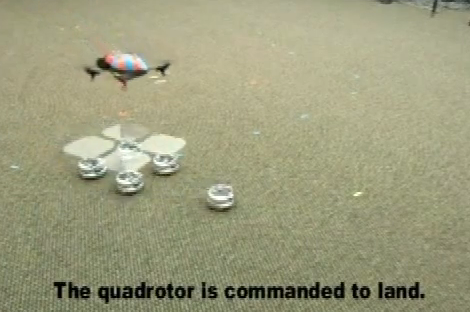
Swarm robotics is really starting to produce some interesting results. This image is from the video embedded after the break that show a group of five robots creating a landing platform for a quadrotor helicopter. The four that actually make up the platform are not in contact with each other, but instead following commands from the leader. We’re impressed by the helicopter’s ability to target and land on the moving platform. Takeoff appears to be another issue, as the platform bots stop moving until the quadcopter is airborne again.
These robots are part of a Graduate project at Georgia Tech. [Ted Macdonald] has been working along with others to implement an organizational algorithm that guides the swarm. The method requires that the robots have an overview of the location of all others in the swarm. This is done with high-speed cameras like we’ve seen in other robotic control projects. But that doesn’t discourage us. If you already have a flying robot as part of the swarm, you might as well add a few more to serve as the eyes in the sky.
[youtube=http://www.youtube.com/watch?v=zbIs7hS-OMs&w=470]
[Thanks Supertroopa via Engadget]















Don’t let them talk to watson or were all done for
This is really cute :D Nice project!
I assume these things use omni-wheels or somesuch.
hey, i send that in 2-3 days ago!
Khepera robots… cool!
Can anyone explain to me the reason for the robots having to decide their own position in the formation, and only being given the relative positions of other robots? Is there a real world application to that aspect of the project other than efficiency?
I think it’s to show their ability to make decisions on the fly, based on what solution is simplest, and how they can all come to the same solution independently.
Real world situation modeling is usually done in GPS-denied and Comms limited situations to represent the worse case senario. Not like the group that does the dancing Quads instead a motion capture studio, that’s wishful thinking.
Imaging the military aspects of this?
Looks like a group of specialized MULE patrolling with one of the new unmanned helicopters.
http://www.youtube.com/watch?v=Wb88Wyqli4w&feature=related
http://www.youtube.com/watch?v=FQvI4YWvLNw&feature=related
The USAF is testing some sick quad-copter designs as well.
hey i worked on that skyball on the firescout! DE-FENCE (clapclapclap)
Did anyone else get the impression of an escort when the followers formed a box around the leader and the quadcopter flew over head?
Happens at about 0:45.
Yes!!
Pretty freaky, actually.
They should upscale these robots, just a little bit, and give them paintball guns.
New Sport!!!
@ZeroCool42: Live creatures don’t need communication to accomplish simple tasks. In school, when the sports teacher said to form a line, you would form it without talking to your colleagues: “you go there, I’ll go here, after him”
So why should robots communicate? They just look at what others do and try to compensate to achieve the goal.
i see army applications all over it.
tactics with drones that just have gps and downlink , it’s up to them to do there bidding.
protect the king command will be of use once again.
I am loving the shear awesomeness of this project! Felt like a real world “Supreme Commander” in some of those formations.
@Fili: I think we could get into semantics with the word “communicate.” A lot of communication is going on when a group of kids get in a line, just may not be verbal.
In this example, I wonder if some sort of hierarchy of the robots is in place so that if two robots aim to take the same position, one always has priority. Or maybe robot fights break out for positions, that could be fun!
It would be interesting to have more robots than needed for certain tasks. Then each bot would have to decide to be part of that team or not.
Of course, it’d still come down to the fat robot and the one with glasses…
This could be a very useful technology for lunar or Mars exploration robots.
I can see several MER type rovers with simple ISRU tending a hopper or a group of small lawn tractor sized bulldozers on the moon preparing a landing site for a larger manned lander.
is it to soon to bow to our robot overloards?
What do the followers do if the leader gets destroyed?
WOW this is phenomenal. the best swarm type project i’ve seen posted here. i’m usually a hater but thanks hackaday, great post!
But are they in fact communicating with each other via their movement…?